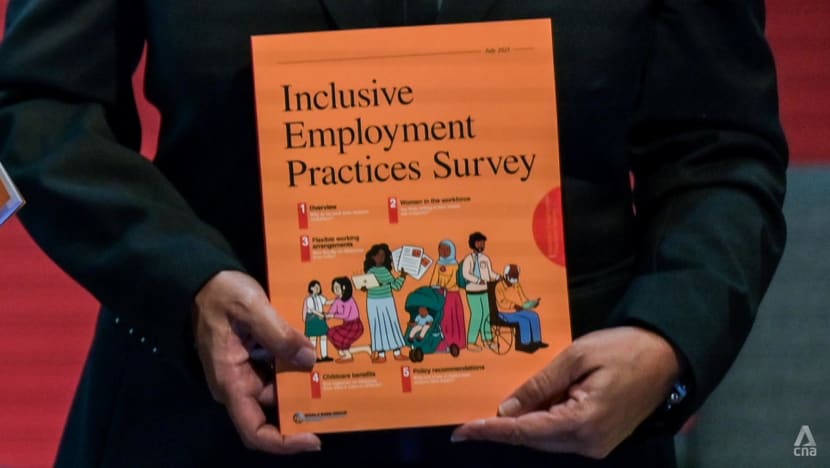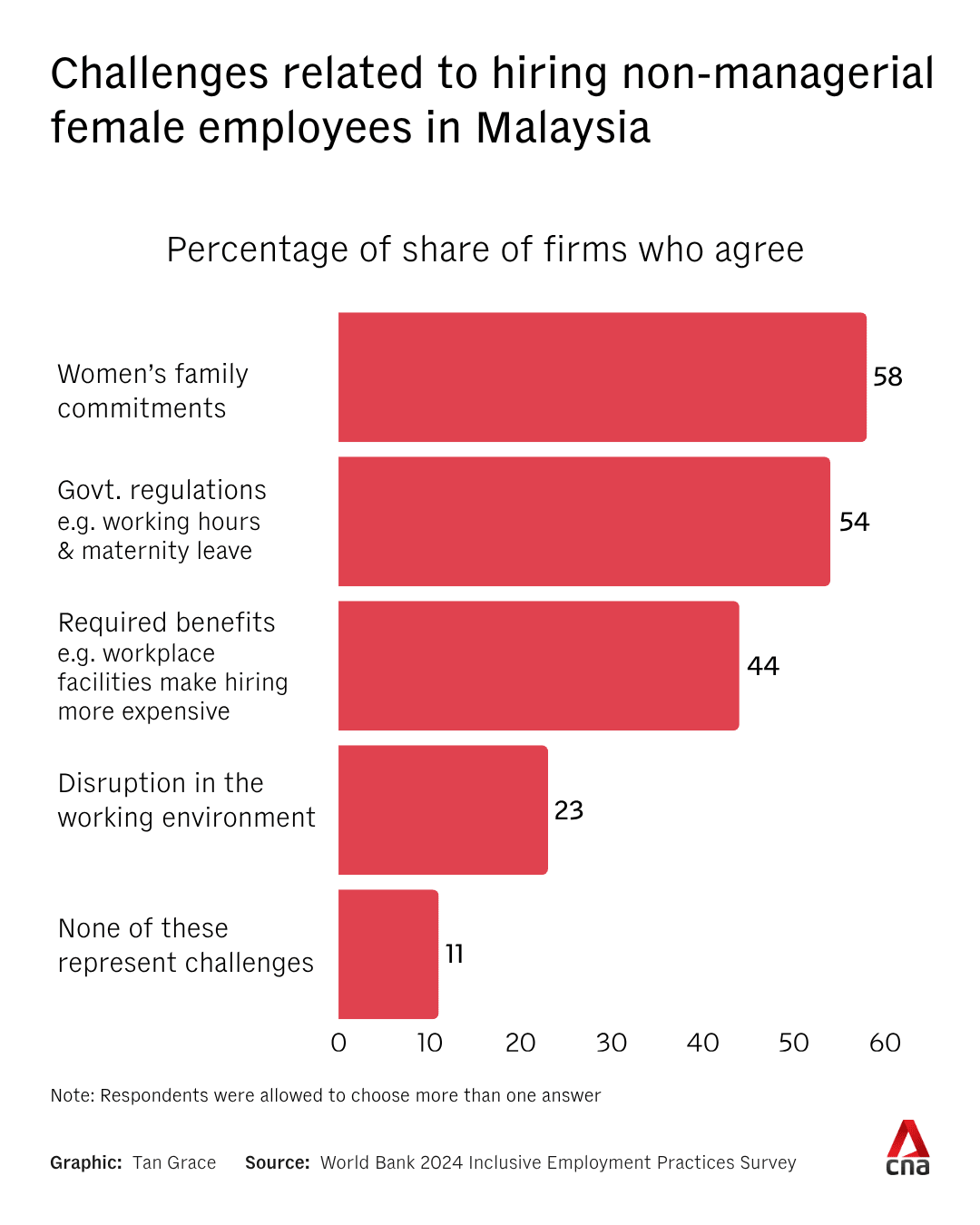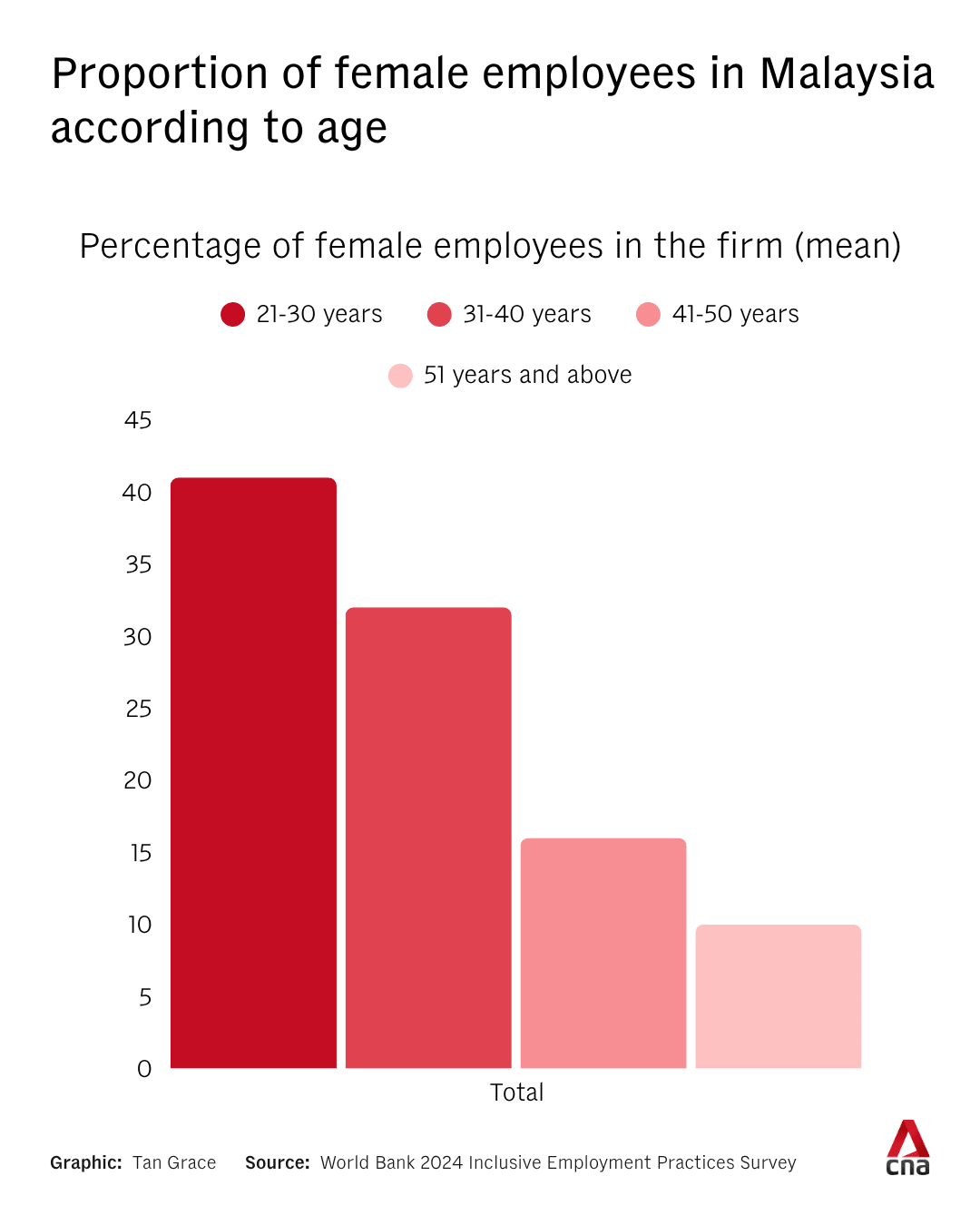‘Lost economic opportunity’: Why are more Malaysian women leaving the workforce after the age of 30?
An inaugural study of 1,500 Malaysian firms by the World Bank also found that more than half cited family needs and maternity leave as barriers to hiring women.

A World Bank Report titled Inclusive Employment Practices Survey that was launched on Jul 22, 2025 in Kuala Lumpur found that familial and maternity regulations are among barriers for firms when choosing to hire women. (Photo: CNA/Fadza Ishak)

This audio is generated by an AI tool.
KUALA LUMPUR: Familial commitments that women have to attend to. Maternity regulations that are in place for when they choose to have children.
These have been identified as among the “significant obstacles” for firms when choosing to hire women, a recent survey of 1,500 companies in Malaysia found.
Launched on Tuesday (Jul 22), the survey report by the World Bank found that for 58 per cent of employers, women's family commitments are a major challenge in recruitment while 54 per cent of these firms cited the provision of maternity leave as a barrier to employing them.
These findings coincided with another trend observed among the firms surveyed - that the proportion of female employees tends to decrease as their age increases.

Women in Malaysia tend to leave the workforce upon starting a family, the report found, and they are unlikely to return without adequate and proper support from employers.
“Without employment practices that adequately support women’s caregiving responsibilities - such as flexible work arrangements and accessible childcare - many women will continue to remain outside of the labour force or resort to informal work in order to balance family and employment,” Malaysian World Bank country manager Judith Green said at the report’s launch.
GENDER GAP IN WORKFORCE ‘PROBLEMATIC’
The World Bank’s report shows that the proportion of female employees at the firms surveyed decreases with age - women between the age of 21 and 30 form the largest share of female employees at 41 per cent.
This is then followed by women between the ages of 31 and 40 years at 32 per cent, those between the ages of 41 and 50 make up 17 per cent and those above the age of 50 at 10 per cent.
“This trend is broad-based across firms’ size, regions, sectors and years of operation,” it said.
The World Bank added: “Unlike in other countries where women often re-enter employment after a career break, Malaysian women’s departure from the labour market tends to be more permanent.
“Malaysia has one of the lowest rates of women taking temporary career breaks, reinforcing this trend of permanent labour market exit.”
Meanwhile, the labour force participation rate for men at 83.4 percent in 2024 was much higher than the female labour force participation rate of 56.6 percent.

Green said that the gender gap is problematic - both from an equity as well as from an economic perspective.
“Malaysian women are on average better educated than Malaysian men, and under-representation in the labour market is a lost economic opportunity - it implies that Malaysia is not fully utilising its human resources,” she said.
Green added that a previous World Bank report found that if female labour force participation rates in Malaysia were to rise to levels seen in advanced economies, the country’s income per capita could grow by 26.2 per cent - or equivalent to a RM9,400 (US$2,200) annual income gain.
She noted that the working-age population has already begun to shrink since 2020 and that this trend posed significant challenges for the labour market.
“These demographic changes underscore the urgency for strategic labour market interventions that can help mitigate the impacts of a shrinking workforce while sustaining economic growth.
“One of the most promising ways forward for Malaysia to do this is by increasing and sustaining women’s participation in the labour force,” said Green.
WHAT CAN BE DONE?
However, it is not all doom and gloom, with over half of the firms surveyed saying that they have put in place key measures to support women at the workplace.
The World Bank said that 54 per cent of firms indicated that they offer hybrid working or flexible working arrangements as part of its childcare benefits, while 53 per cent indicated that they have an onsite or near-site childcare or daycare facility.
Additionally, 47 per cent of firms offer paid parental or family leave, separate from annual leave.

In a panel discussion at the report launch, Hamidah Naziadin - the former chief people officer of CIMB Group - said that employers need to understand the need for family-friendly policies. The CIMB Group is one of the largest banking groups in the country.
Hamidah added that these policies must be looked at as an investment rather than thinking of it as just a cost. During her tenure at the banking group, CIMB introduced a six-month maternity leave scheme and one month of paternity leave.
In Malaysia, female employees are typically eligible for 98 consecutive days of paid maternity leave while males are eligible for only seven days of paternity leave.
She said that there were those who questioned the extended paternity leave.
“When you formulate policies, you do it for the majority. Such family-friendly policies give you greater value in terms of branding and help to promote productivity through employees who find the company to be thoughtful and caring,” she said, adding that strong policies come from understanding the employees’ needs.
She also believed that the flexible work arrangements, for example, are here to stay.
“At the end of the day, it is the employees who make up the company. Let’s do what we can to provide them with that support system. One important word is trust. If you want to implement policies, a lot of it will require trust.“
Meanwhile, Nazrul Aziz - who is the group chief strategy officer at TalentCorp - said that smaller firms face the biggest challenge to implement family-friendly policies in order to attract women back into the workforce.
TalentCorp is an agency under Malaysia’s Ministry of Human Resources that drives the country’s talent strategy.
Nazrul said that only 30 per cent of Malaysians work with multi-national companies or government linked companies while the majority work with the MSMEs.
“If you want to make a shift in the ecosystem, we have to go to this group but of course with the guidance from the bigger companies,” he said.


















